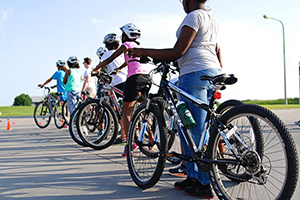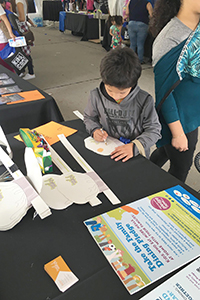By BETSY TAYLOR
In Omaha, Neb., there are multiple programs designed to curb childhood obesity, including programs providing healthy meals at day care facilities, school activities to increase physical fitness, and a campaign coaxing families to dine together more often, because on average children consume better nutrient-rich foods when they eat more meals at home.

Students from Girls Inc. of Omaha take part in a 2015 bike safety course presented by Live Well Omaha.
For 20 years, a forum of organizations known as Live Well Omaha has striven to improve the health of those in the community. In 2006, 75 partners, including those already in Live Well Omaha, began meeting to strategize about programs specifically to combat childhood obesity. Alegent Health — which is now CHI Health — served as an umbrella organization and funder for the groups.
In 2008, the group began offering Live Well Omaha Kids programs to encourage healthy nutrition and fitness behaviors for children and their families. Individual programs have experienced successes; yet today, one in four children in the Omaha metro area is at an unhealthy weight, either overweight or obese.
Clearly something more was needed. To support large-scale, lasting change, Omaha-area organizations are transitioning to a collective impact approach to address this issue, explained Kelly Nielsen, CHI Health's division director of healthier communities and community benefit. Omaha-based CHI Health, part of Englewood, Colo.-based Catholic Health Initiatives, includes 15 hospitals in Nebraska and Iowa.

Nielsen
Collective impact work is based on the idea that "large-scale social change comes from better cross-sector coordination rather than from the isolated intervention of individual organizations," wrote John Kania and Mark Kramer in their 2011 Stanford Social Innovation Review article outlining how collective impact works. Both men are on the leadership team of FSG, an international consulting firm that works with nonprofits and governments to support social change. Kania is the global managing director and Kramer is the co-founder and a managing director of FSG.
"Unlike most collaborations, collective impact initiatives involve a centralized infrastructure, a dedicated staff, and a structured process that leads to a common agenda, shared measurement, continuous communication, and mutually reinforcing activities among all participants," Kania and Kramer wrote.

A child decorates a paper chef's hat during a back-to-school fair at OneWorld Community Health Centers in Omaha, Neb., last year. The hats call attention to Live Well Omaha Kids' family dining pledge campaign. The pledge encourages families to cook and eat together more often at home. OneWorld provides health care and social services.
Creating a backbone organization
A collective impact approach uses a backbone organization, a separate organization with staff that has the skills to support the entire initiative. Currently, CHI Health is funding a position at the Live Well Omaha nonprofit to support the creation of a Live Well Omaha Kids backbone organization. This is part of a transition to allow the Live Well Omaha Kids programs to have a centralized infrastructure and a dedicated staff. The backbone organization convenes the community partners who are working on aspects of reducing childhood obesity.
Sarah Sjolie, the executive director of Live Well Omaha, explained when one health system was serving as the umbrella organization, the effort wasn't perceived as a true community-driven effort. "The current iteration of the collective impact effort is an evolution of the (original) coalition," she explained.
The number of community groups involved in the Live Well Omaha Kids work has ebbed and flowed over the years, said Sjolie, with about 40 organizations in the area that currently work to prevent childhood obesity. A Live Well Omaha Kids steering committee meets regularly. It includes representatives from CHI Health as well as Children's Hospital & Medical Center in Omaha, universities and colleges, Douglas County government and health departments and other community groups. Omaha is located in Douglas County.
"In the past, organizations met on new projects or to 'share and make aware,'" Sjolie said. The collective impact approach takes the collaboration to a new level of mutually beneficial activities, she said.
Getting on the same page
The steering committee is coordinating an analysis to determine what works locally and across the country to prevent and reduce childhood obesity. Once that analysis is complete, the members will decide on shared goals and conventions for measuring progress.
Currently, those working to encourage healthy behaviors in children collect different data measures in different ways. "The intent of identifying and collecting shared data is so we can all work toward impacting the same metrics," Nielsen said.
Live Well Omaha Kids is figuring out the best data to collect to track change, and how and where to collect it, said Sheena Kennedy Helgenberger, coalition director for Live Well Omaha Kids. Her position is new and funded for three years by CHI Health.

Sjolie
Helgenberger is conducting interviews with coalitions working on childhood obesity elsewhere in the nation to learn from their work. One of the steering committee members, the Omaha-based Gretchen Swanson Center for Nutrition, also is evaluating evidence-based approaches to reducing childhood obesity being employed in other communities.
The landscape analysis will include assessments of the age at which children derive the greatest benefits from antiobesity programming, and the settings where interventions should be offered, whether at day care, school, in a clinical or community setting, or at home, involving their family members.
A public health student is conducting additional analysis, delving into the community health needs assessments from 2012 and 2015 for relevant data. The assessments include data from two hospitals that serve children and school-based health centers. Both health needs assessments identify overweight and obese children as a priority health issue.

Helgenberger
Common agenda
The steering committee will review the findings this month. They'll decide on target geographic areas for Live Well Omaha Kids; the target audience or audiences; and whether to focus on programs, policy or nutrition and fitness education, changing the physical environment to promote outdoor activity, or a mix of all of the above.
Not every organization working on childhood obesity in Omaha needs to do the same thing, said Sjolie. Moving forward, the strategy will be to offer mutually reinforcing activities with measurable outcomes. Each participating organization will set out specific activities where it has had success and detail how its contributions will support the overall effort to address childhood obesity.
Collaborators believe the common agenda, measures and goals will demonstrate commitment and results to potential grant funders.
Nielsen said, "We couldn't really tell the story of how this work was overall impacting our community in terms of childhood obesity and nutrition and physical activity." That's about to change, said those involved in the work.
Copyright © 2017 by the Catholic Health Association
of the United States
For reprint permission, contact Betty Crosby or call (314) 253-3490.